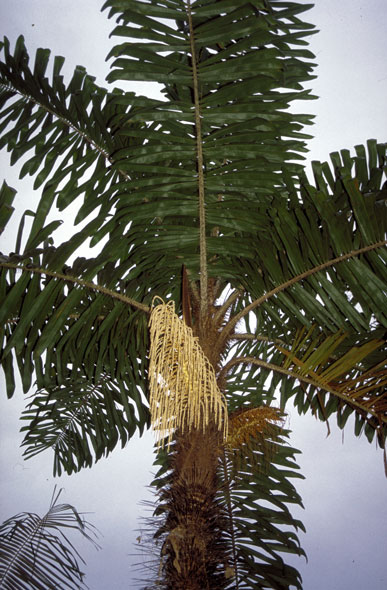 |
Palm |
 |
Palm |
Aiphanes grandis is endemic to the western slopes of the Andes mountains in Ecuador, at elevations between 1000 and 2000 m. It occurs in cloud forest in the central and southern parts of the country.
It is a large, solitary palm tree, with a stem up to 20 m tall and 1020 cm in diameter. The stem and leaves are fiercely armed with long, black spines. The leaf blade is 200250 cm long with up to 50 leaflets on each side, briefly jagged at apex, inserted in groups and pointing in different directions. The inflorescence is 11.5 m long, with up to 200 spreading branches. Flowers are white to pale yellow and fruits 23 cm in diameter, dull green and covered with brown, loosely attached bristles. The combination of jagged leaflets and large size distinguishes the species from all other South American palms.
Little is known about the natural history of the species. The palm heart is edible, and its seeds are sometimes pureed and cooked with crude cane sugar to form a nougat-like paste.
The estimated loss of potential habitat for A. grandis, based on habitat modeling, is 62%, most of which has occurred over the last 3040 years. The west Andean mountain forest in southern and central Ecudor, where A. grandis occurs, harbors a high number of endemic plant species. It is also the home to remnant populations of such conspicuous palm species as Ceroxylon ventricosum and C. alpinum subsp. ecuadorense, both considered vulnerable. Aiphanes grandis, as with other large palms, is often left over when the forest is converted into pasture, but as with other palm species, it is unable to regenerate in a tall grass-dominated vegetation. Furthermore, local farmers may object to its presence due to the fiercely armed stem and leaves that constitute a problem to grazing cattle and hence try to eradicate it from their pasture fields.
 |
| Habit of Aiphanes grandis at Sambotambo, southwestern Ecuador. Photo by F. Borchsenius. |
Increasing awareness of the critical situation of the mountain forests in western Ecuador has led to the establishment of several small, privately funded protection areas, but it is not known if a substantial population of Aiphanes grandis occurs inside any of these. The only national park on the west-Andean slopes in Ecuador is located north of the known range limit of A. grandis.
A population census and search for additional forest remnants housing the species should be performed, and its requirements for natural regeneration should be investigated. The possibilities for in vitro propagation of the species should also be examined.
Dr. Finn Borchsenius, Department of Biological Sciences, University of Aarhus, Denmark (finn.borchsenius@biology.au.dk)
Hugo Mogollon, Finding Species, Ecuador (hfmogollon@findingspecies.org)
Borchsenius, F. & Bernal, R. 1996.
Aiphanes (Palmae).
Flora Neotropica Monographs 70: 1- 95.
Borchsenius, F. 1997a.
Patterns of plant species endemism in Ecuador.
Biodiversity and Conservation 6: 379-399.
Borchsenius, F. 1997b.
Palm communities in western Ecuador.
Principes 41: 93-99.
Borchsenius, F. & Balslev, H. 1989.
Three new species of Aiphanes (Palmae) with notes on the genus in Ecuador.
Nord. J. Bot. 9: 383-393.
Borchsenius, F. & Skov, F. 1999.
Conservation status of the palms of Ecuador.
Acta Botanica Venezuelana 22: 221236.
Borchsenius, F., Borgtoft Pedersen, H., and Balslev, H. 1998.
Manual to the palms of Ecuador.
AAU Reports 37, Dept. of Systematic Botany, University of Aarhus (217 pp.).
Mogollon, H., Borchsenius, F. & Skov, F. unpublished data, 2006.
Results from habitat modelling of Ecuadorian palms using Maxent version 2.3 software (http://www.cs.princeton.edu/~schapire/maxent/)